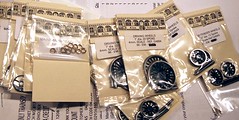This is a small selection of the parts needed to finish the GWR Armstrong locomotive kit. Mostly it consists of wheels but there are some other odds and sods. What’s not there is a motor or gearbox, these are still in the post. 70 quids worth of bits to add to the cost of the kit.
Most newbies wonder why model locomotive kits aren’t supplied with all the parts needed to complete them. It is a bit of a shock to look at the price of a box of bits only to realise that you have to add another chunk of cash, sometimes doubling the final bill, if you want to finish and run the model.
Some kitmakers provide beginners kits that are complete, others give you wheels or gearboxes as they manufacture their own and want you to use them. Most don’t bother leaving the poor modeller to work out what else is required. In the popular scales they usually help with a list but get off the beaten track (e.g. to 3mm scale) and you are on your own.
Now I don’t care. Having built more locos than is good for me, I have my favourite wheels, motors and gearboxes. When I buy a model I know roughly how much to add and where to get the extra parts. For the record, my favourites are: Romford wheels, Mashima Can motors & High Level or Branchlines gearboxes depending on the model.
Of course the beginner knows nothing of this. He or she wants it all in a box and wants to know why the model railway world has grown up in this apparently user-unfriendly way.
The reason is simple. It might at first glance appear to make things difficult but actually makes life easier. The Armstrong is to be built to EM gauge – so I need EM wheels. There are OO ones in the kit and they will be left over at the end. There’s nothing I can do about this. Motors and gearboxes are similar. If this kit had included one, it would have been a K’s one-piece unit. Fine if you like the smoke effects produced when this gives up the ghost but I prefer to put a good unit in first time so the loco is only assembled once.
Complete kits have to be built down to a price. This means you get cheap parts and not necessarily good ones. Worse, if you want to change something then you still have to pay for the part you don’t want and then replace it with the one you do.
In theory the model shop fills in the gap. New modellers want to buy a kit and the experienced man behind the counter offers sensible advice based on years of experience to help with the extra parts. Of course there are very few model shops and even fewer that supply locomotive kits. Mail order and chasing the cheapest price have seen to this. Manufacturers now have to fill in the gaps – fine most of the time but they often don’t stock all the parts themselves so you don’t have the one-stop solution.
I suppose this is all part of the learning curve for a modeller contemplating building their first locomotive. It is certainly a good reason for joining a club so you can learn from others mistakes.

No comments:
Post a Comment